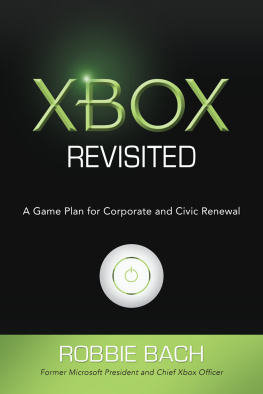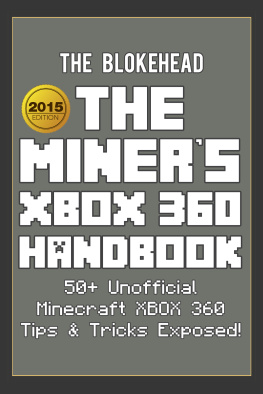All rights reserved. No part of this book may be used or reproduced in any manner without written permission except in the case of brief quotations embodied in critical articles or reviews.
For Pauline
My love, my friend, my soul mate
AUTHOR'S NOTE
A PERSONAL ACT II
I recently attended my twenty-fifth reunion at Stanfords Graduate School of Businessa traditional milestone to catch up with old friends, reconnect with others, and take stock of your professional development. Almost every conversation began with classmates trying to size up each others accomplishments since our business school days. Stanford is a collegial place, but most of us are Type-A competitive personalities, and this mutual evaluation was just part of the reunion dance:
So what are you doing now?
I retired from Microsoft after twenty-two years.
Im sure my answer to this deceptively tame question left a hanging chad of doubt in many minds about my internal drive and motivation. Nobody retires at the age of forty-nine.
My decision to leave Microsoft in 2010, however, was not a retirement. It was a self-imposed period of reflection, a time to step back from the frenetic pace of my professional and personal lives to think deeply about how I wanted to have impact going forward. If my twenty-two years at Microsoft had impact in the business arena, how did I want my Act II to play out? How did I want to spend the next twenty-two years, more or less, to generate positive change beyond the corporate world? How could I take the lessons Id learned from the challenges of building several successful businesses at Microsoft and apply them to broader civic and social issues? How could I have deep, lasting impact?
To explore the answers to these big life questions, I began writing. At first this was just an outleta way for me to express my frustrations, organize my thoughts, and evaluate opportunities for change. I reflected on the lasting value of my experiences as a leader at Microsoft, the transformative nature of my deep involvement with organizations like the Boys and Girls Clubs, and my belief in the power of sports to transcend differences. This combination of business experience, nonprofit commitment, and sports passion are unique traits that have shaped and formed my world view. When all of the evaluating was done, I found myself focusing on areas where I had real value to addstrategic thinking, organizational management, and driving change to address complex problems.
I went back to square one of the strategy process I had learned at Microsoft, in particular during my time creating and leading the Xbox business, and asked myself a few simple questions: Could I create a practical strategy for bringing order to civic issues? Could my experiences in the world of video games translate to the tumultuous world of government and community organizations? The irony implied in those questions was not lost on me, but I continued to write, and my transformation from business leader to aspiring citizen activist and self-described civic engineer was underway.
Xbox Revisited presents a common-sense, strategic framework for addressing complex problems. It can be used in personal, business, and civic contexts to plan new approaches and manage change effectively. It is also a case study that demonstrates how the Xbox team used early iterations of this strategic framework to build the business from a start-up to the leading video game company in the world. Most importantly, this book demonstrates how strategic business concepts can be applied to re-engineering our approach to civic matters. It is a call to actiona summons to each and every reader to recognize the challenges we face as a country and to demand that decisive action be taken. Ultimately, I want this book to ignite real conversation about the changes required to address the complex issues our nation faces.
Being patriotic and caring about our country may be somewhat old-fashioned, but I refuse to accept that the days when individuals could make a difference are over. I refuse to accept that we are powerless in our ability to change the direction of our country. I refuse to accept that civic issues are the province of think tanks, policy experts, and politicians.
I believe we can take on the challenges in our future, including highly complex ones that seem insurmountable or beyond our own abilities. To do that, we need two critical elements: a practical strategic framework that guides our actions and real leaders who can implement that strategy successfully. We need committed individuals who drive impactchange that has a deep, positive, social effect. I hope that Xbox Revisited can be a beacon of common-sense thinking that sets that type of change in motion.

THE DARKEST OF DAYS
I woke up in my hotel room in midtown Manhattan on September 11, 2001, ready for another day of grappling with the toughest challenge of my career at Microsoft. I had taken the red-eye from Seattle for a public relations tour to introduce journalists to the Xbox console, a critical step in our efforts to get Microsofts entry into the video game business back on track.
Four months earlier, on May 16th, I had presided over the nightmarish Xbox launch event at E3, the gaming industrys largest and most important convention. The disaster had centered on the simplest of components: the on/off button. In theory, you press the button, the device turns on, and when you press it again, it turns off. Nothing fancy, complicated, or difficult involved; at least that is how it was supposed to work.
I remember standing at the podium at 8 a.m., ready to present Microsofts game-changing console to a room full of hung-over E3 attendees. When I hit the Xbox on/off button, nothing happenednot a flicker, not a beep, not even a Microsoft blue screen. Just me and a silent, blank television. As Apollo 13 Commander Jim Lovell said, Houston, weve had a problem here. Although our issues were not life threatening, there was no abort option. We still had to land Xbox on the moon, pick up the rocks, and bring them home. That moment was the beginning of a long, difficult mission.
Four months later, I was preparing for yet another day in the can-we-get-Xbox-launched challenge. September 11 actually began on the night of September 10 with a flight from Seattle to JFK airport in New York followed by a cab to the Marriot Marquis in Midtown. I went to sleep with no more cares in the world than my rude Q&A talking points for the difficult questions I would be asked on the tour. Oh... and we had just a few more manufacturing problems and the actual games might not be finished in time for launch. As Microsofts Chief Xbox Officer (CXO), dealing with high-grade anxiety had become a way of life.












